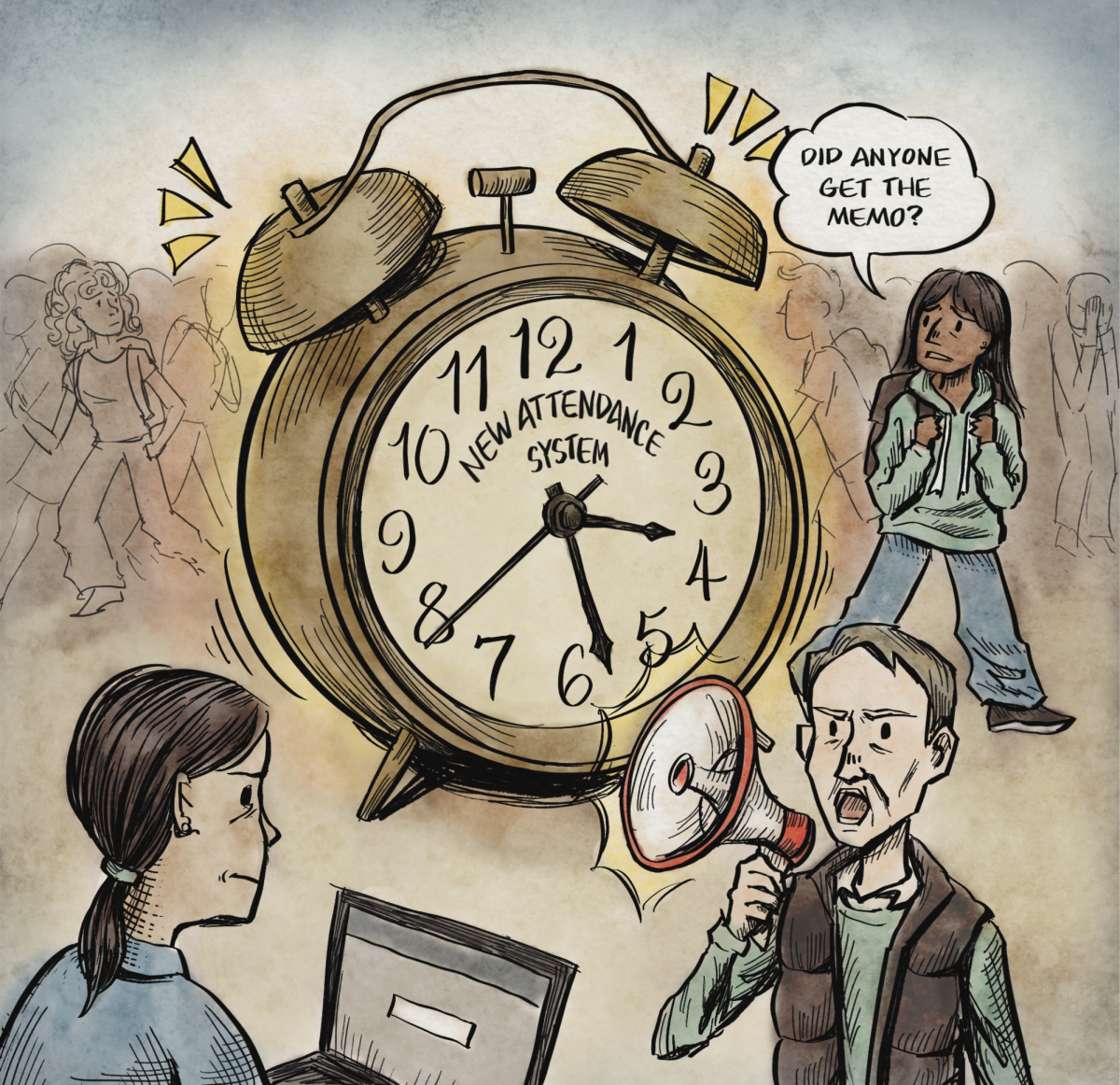For Lori McCormick’s son at Fletcher Middle School, his Academic Success class — a key part of his Section 504 plan — seems almost too good to be true. In the small, cozy classroom, he receives 2-1 individualized attention from teachers who are supportive and caring. He has focused time to finish all his week’s homework. And as a sort of protective shield, he has the opportunity to retake any sections on his math tests, removing the stress of any potential simple mistakes.
McCormick said having testing accommodations as part of a 504 plan has been transformative for her son’s academic journey.
“It’s a huge relief. I don’t think he would be as confident today if you didn’t have accommodations. His academic support team at his middle school is solid. They’re educators that care deeply about his success, and he knows that he can lean on them for support,” McCormick said. “It’s the reason why he still hasn’t given up on himself academically.”
However, securing these accommodations was no small feat. While PAUSD excels at educating many students, parents like McCormick say those needing special accommodations often face significant challenges and families face additional costs to access the same quality of education. McCormick said for her son, the process was taxing both financially and emotionally.
“We started asking for additional support in first grade. He got his IEP at the end of fifth grade,” McCormick said. “I pretty much blacked out (the costs of getting an accommodation) because it was so traumatic. It was several thousands dollars, somewhere in the $7,000 to $9,000 range, and I was looking at changing school districts and physically moving our family away.”
Under Section 504 of the Rehabilitation Act of 1973, every qualified student with disabilities is protected from discrimination in federally-funded education programs. Public schools create 504 plans for students, which are personalized learning plans that outline student-specific accommodations to ensure equal learning opportunities.
504 plans are different from Individualized Education Plans, which are given to students whose learning disabilities affect their performance substantially enough to require specialized instruction, while 504s are meant for students whose disability interferes with their learning. IEPs also offer modifications while 504s offer accommodations, which public school attorney and special education expert Miriam Kurtzig Freedman said vary drastically in their intention despite their similar sounding designations.
“An accommodation is a change in a course, test or requirement that a student with a disability needs in order to have access to participate in a course. A modification is also a change that a student needs for access, but it does fundamentally alter the standard or lower the expectation of a course,” Freedman said. “An accommodation levels the playing field while a modification changes the game.”
Freedman also said since the Rehabilitation Act became law, the number of 504 plans has far exceeded the expected amount.
“We expected one or two percent of students to need accommodations,” Freedman said. “Now in some schools the number is higher than 30 percent. Not because kids are more disabled than before, but because the system is broken.”
Evaluation Process
Once a student or parent requests an evaluation for a 504 plan, Jason Krienke, Greene Middle School’s 504 lead, said a Section 504 team performs an in-depth analysis on the student’s background to determine if they qualify for accommodations.
“The team assesses a student’s eligibility for a 504 plan by reviewing their educational and assessment information including grades, test scores, medical records, teacher reports and other assessment information,” Krienke said.
Paly school psychiatrist Pamela Lin said Paly also runs numerous internal assessments and utilizes reports from medical professionals. Afterwards, a Section 504 team consisting of counselors, psychiatrist, teachers and parents determine whether accommodations are appropriate for a student.
“We do cognitive testing, academic testing, and then we have a rating scale survey that looks into ADHD symptoms, anxiety symptoms or depression symptoms,” Lin said. “We look at medication side effects, hearing and vision and some students have unique health needs that we need consultation with outside providers.”
The evaluation process varies for each student, ranging from simple to complex depending on their unique circumstances. Junior Kat Farrell said her 504 team evaluated her for dyscalculia by monitoring her behavior in many different ways.
“They observe you in your classroom, how you interact with your peers, how you listen to the teacher and how you get your work done,” Farrell said.
Students can also submit outside medical evaluations for consideration. Morrissey-Compton Educational Center is a Bay Area non-profit that provides diagnoses and evaluations for students with learning disabilities –– According to Executive Director Dr. John Brentar, the evaluation process by medical professionals involves three to five testing sessions with interviews, IQ testing, academic assessments, processing tests and mental health screenings.
However, demonstrating evidence of a learning disability does not always warrant a testing accommodation. Brentar said schools often look for how a student’s condition may lead to functional limitations in their academics.
“(Schools) want to see some impact in a student’s day-to-day life, and academically, how this diagnosis impacts their performance,” Brentar said. “If your academic performance is fine, you probably won’t need nor get an accommodation.”
Brentar said since the Varsity Blues college admissions scandal in 2019, where high-profile parents paid to obtain accommodations that created favorable testing conditions for their children, schools have become stricter in the process of approving 504 plans.
“In 1990, it was fairly easy to get accommodations through school districts and private schools,” Brentar said.” But as word got out that (504s are) easy to get, school started clamping down and making it a little more challenging to qualify.”
After a Section 504 team determines a student is qualified for a 504 plan, a detailed learning plan outlining specific accommodations is created and shared with their teachers.
Accommodations can come in many different forms. According to a June 2022 report conducted by the Government Accountability Office, the majority of accommodations approved nationwide for standardized testing were for “Extra Time”, in which students would most commonly receive 125%, 150% or 200% as much time as standard. In order, the next most common were “Adjustments to the Testing Environment,” “Auditory or Visual Assistance,” “Alternate Test Formats” and “Breaks.”
Farrell, whose accommodations include a restriction on cold calling, said she has noticed a drastic improvement in her academic performance after being aided by her 504 accommodations.
“After I got my accommodations, life was much easier for me,” Farrell said. “(I had) extended testing time, notes and all the things I so desperately needed to pass my classes.”
Disparities in 504s
A common criticism of testing accommodations is its lack of accessibility, which perpetuates racial and socioeconomic disparities between students nationwide.
According to a 2012 study by The Advocacy Institute, while 51.7% of students nationwide are white, they make up 65% of students with 504 plans.
At Paly, the imbalance is even greater. PAUSD data reported that white students make up 58.4% of all 504 plans despite accounting for only 35.4% of the student population. In total, 26% of white students have testing accommodations, compared to 13.3% of Hispanic students, 11.6% of African American students and 8.2% of Asian students.
Freedman said the inequity could be due to less familiarity with the system in lower-income communities, where there are typically more minorities.
“Many families of children who live in areas of poverty may be unaware about requesting accommodations for their children,” Freedman said.
Dr. Monica McHale-Small, Director of Education at The Learning Disabilities Association of America, said insufficient resources for those with learning disabilities lead to disproportionate numbers of 504 plans in lower-class communities.
“What we’re seeing is not necessarily an over-identification of middle and upper middle-class kids. It’s an under-identification of kids from less financially secure environments where there’s a shortage of school counselors and psychologists,” McHale-Small said. “There’s a lot of kids in under-resourced schools who have learning disabilities or ADHD and never get diagnosed, and therefore, never get an IEP or a 504 plan.”
Costs for testing accommodations can add up, creating roadblocks for lower-income parents. Representatives from two disability advocacy organizations cited evaluation costs that ranged from $2,000 to $7,000.
Responses to a Schoology survey of 47 students conducted by The Campanile on April 26 indicated that accommodations at Paly typically cost anywhere from several hundred dollars up to $10,000.
Brentar said while some schools in the Bay Area offer financial aid to students who cannot afford evaluations, often, the cost surrounding learning disabilities and testing accommodations can make them inaccessible.
“Tutoring and therapy is really expensive in this area, so if you’re paying $200 or $300 a week for therapy, that’s $1,200 a month or $14,000 a year,” Brentar said. “(In addition to getting an accommodation), the costs add up pretty quickly.”
In addition to affordability, Noone said parental values can hinder the process of obtaining an ADHD diagnosis.
“On top of the expense, many people have parents that don’t believe in learning disabilities and accommodating them,” Noone said.
Exploitation Potential
While instances of outright exploiting testing accommodations are rare, the system has the potential to be exploited to gain an academic edge. However, the Varsity Blues scandal exposed the potential for fraud in the testing accommodation system. As a result, testing accommodations have become increasingly difficult to obtain, requiring more extensive documentation and corroborating evidence.
While Lin said she tries to avoid thinking that any students may be trying to gain an advantage, she also said Paly recognizes the high levels of academic intensity and the potential for students to try to find ways to unfairly improve their academics. “We know a lot of students have high levels of anxiety here and there’s a level of intensity and competitiveness that can really exacerbate students’ feeling as if there is something really wrong (with them),” Lin said. “We want to be sensitive to that and be really mindful of our student journey because we understand it can be challenging to get through high school, especially in a competitive environment.”
Sophomore Oliver Chancellor said he is worried the potential for exploitation of 504 plans could lead to the approval process becoming even more difficult to access.
“It’s immoral and unjust, because that’s what people are going to think of people that actually have ADHD. They’re automatically going to come to the conclusion that (we are) probably faking it and just trying to milk it,” Chancellor said. “People who are faking make it harder for the people that actually have the disorder.”
Freedman said she believes the current state of testing accommodations is a symptom of larger issues in education.
“I believe schools are caving in unnecessarily,” Freedman said. “If somebody gives you a freebie with no consequences, and you think it’s gonna help, why would I blame you for going for it?”
Neglect for Accommodations
While students, school officials and families are supposed to coordinate with teachers to access 504 accommodations in classrooms, some say they have had classes where their testing accommodations were not honored.
A female sophomore, who agreed to an interview only on the condition of anonymity because she feared resentment from her teacher, said she had a P.E. teacher who continuously disrespected her 504 accommodation during her freshman year.
“I had the accommodation to moderate what we were doing, and my teacher didn’t respect that,” she said. “He put me with the other kids even though I was supposed to be able to go at my own pace.”
Another female sophomore who also requested anonymity because she feared resentment from her teacher said she was accused of cheating on an exam after using her legitimate testing accommodation.
“My 504 says I need (my test) to be read aloud if I want, and my teacher said, ‘No she can’t do that’ to the helper because she said the helper would be telling me the answers by reading the question aloud,” she said.
A male senior said his teacher neglected his accommodations to the point where he was forced to drop the class.
“I had a teacher freshman year disrespect my accommodations blatantly several times,” the male senior said. “I ended up dropping the class because I was having almost daily panic attacks.”
Senior Noah Boyarsky also said some teachers use sly methods to bypass students’ accommodations.
“When teachers don’t follow the accommodations, or more often, find ways to narrowly get around following them while still technically following the rules, I struggle and spend hours and hours longer on my work than necessary,” Boyarsky said.
Farrell said although dealing with stubborn teachers may be frustrating, students should stand up for themselves when their accommodations are disregarded.
“You are a young adult and you have to advocate for yourself,” Farrell said. “Go up to that teacher and say, ’This is my 504. This is a legal document, and the state of California takes this very seriously,” Farrell said.
Standardized Testing
ACT Vice President of Accessibility and Operational Strategy Katie Featherson said when testing companies consider accommodations, they strive to find the balance between eligibility and appropriateness to ensure test validity and allow individuals to accurately display their academic aptitude.
“We have to keep some processes to make sure that it’s fair and equitable,” Featherson said. “What we’re really trying to do is to balance fairness and equity by aligning with what happens at school, then we’re making sure that it’s people that really need these supports that are asking for them. And that way we can work together to make sure, it’s just not someone who’s maybe trying to just do better on the test.”
Featherson also said ACT has increased its reliance on local schools when considering accommodations in an attempt to be as cooperative as possible.
“The ACT is governed by federal law around this, so that gives us guidance about what we have to legally do,” Featherson said. “In the last several years, we’ve taken a different perspective and asked, ‘What do our students need for access?’ and ’How do we make that fair and equitable for all students, not just students with disabilities.’”
However, securing these accommodations from major testing organizations can still be challenging. Senior Anjali Battacharya said despite having testing accommodations at Paly for chronic migraines, she was denied accommodations by the College Board.
“My submission for the accommodations was my 504,” Battacharya said. “I submitted a letter from the neurologist, and they said there wasn’t enough information about my diagnosis, even though it was a medical letter. They told me you can provide more information and testing and stuff that you’ve done, but I don’t have anything more to prove it with.”
McHale-Small said in these types of situations where students are unable to gain accommodations, schools must be proactive and assertive in advocating for their students.
“(Counselors should be) really proactive, and especially in testing accommodations. This is something that is really their value, and they have a lot of power in the process,” McHale-Small said. “This is one of their big responsibilities to kids with disabilities. It’s their job to coordinate paperwork and make sure the whole process is happening.”
Despite ongoing challenges and complexities in the system, McHale-Small said testing accommodations are steadily improving by enabling a more level playing field for students with disabilities. She said although many challenges exist in ensuring equitable and appropriate access to testing accommodations, historical context provides valuable perspective on the progress that’s been made.
Conclusion
“Coming from a time before I started my career, I had family members who were told, ‘You can’t come to school,’” McHale-Small said. “And back in the day, schools could say, ‘Sorry, we don’t have any programs for you, you’re on your own.’ So things have definitely improved, and they’ve improved because of those federal laws. We’re not always implementing them fully, but what is in the law in terms of IDEA and Section 504 are good, and if we follow those laws, kids will succeed more.”
Boyarsky said he values his 504 plan and testing accommodations for reducing the daily challenges that come with being neurodivergent.
“Neurodivergent people work hard to exist every day, not because we are flawed, defective, or broken, but because the world isn’t set up for people like us,” Boyarsky said. “504s are an amazing way to make life that much easier for us.”















